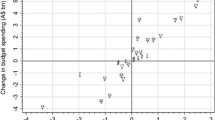Abstract
This article evaluates three measures introduced by the Australian Federal Government in 1999 and 2000 that were designed to encourage private health insurance and relieve financial pressure on the public healthcare sector. These policy changes were (i) a 30% premium rebate, (ii) health insurers offering lifetime enrolment on existing terms and the future relaxation of premium regulation by permitting premiums to increase with age, and (iii) a mandate for insurers to offer complementary coverage for bridging the gap between actual hospital billings and benefits paid.
These measures were first evaluated in terms of expected benefits and costs at the individual level. In terms of the first criteria, the policy changes as a whole may have been efficiency-increasing. The Australian Government mandate to launch gap policies may well have created a spillover moral hazard effect to the extent that full insurance coverage encouraged policy holders to also use more public hospital services, thus undermining the government’s stated objective to relieve public hospitals from demand pressure. Without this spillover moral hazard effect, there might have been a reduction in waiting times in the public sector. Secondly, the measures were evaluated in terms of additional benchmarks of the cost to the public purse, access and equity, and dynamic efficiency. Although public policy changes were found to be largely justifiable on the first set of criteria, they do not appear to be justifiable based on the second set. Uncertainties and doubts remain about the effect of the policy changes in terms of overall cost, access and equity, and dynamic efficiency. This is a common experience in countries that have considered shifts of their healthcare systems between the private and public sectors.

Similar content being viewed by others
Notes
1Similar arguments would apply to other countries, such as The Netherlands and Germany and, increasingly, even to the UK with its growing market share of private health insurance.
2Average cost weights give an indication of the costliness and, therefore, the intensity of treatment for separations. As stated by the Private Health Insurance Administration Council (PHIAC): “The costs weights represent the costliness of an AR-DRG [Australian refined diagnosis-related group] relative to all other AR-DRGs, such that the average cost weight for all separations is 1.00.”[16]
3Any patient entering a public hospital may choose to be publicly or privately admitted. Private admission entitles the patient to a choice of doctor. There may be co-payments associated with private patient admission, but not with public patient admission in a public hospital. Otherwise the differences between the two categories of patients are insubstantial.
4The promotion was so successful that the government extended the deadline to 15 July 2000 to accommodate the backlog in the processing of new policies.
References
Woolridge M. Legislation introduced to reform private health insurance. 1997 Nov 27 [media release; online]. Available from URL: http://www.health.gov.au/archive/mediarel/1997/mw14097.htm [Accessed 2005 Jan 18]
Hall J, de Abreu Lourenco LR, Viney R. Carrots and sticks: the fall and fall of private health insurance in Australia. Health Econ 1999; 8: 653–60
Frech III HE, Hopkins S, MacDonald G. The Australian private health insurance boom: was it subsidies or liberalised regulation? Economic Papers 2003; 22(1): 58–64
Vaithianathan R. A critique of the private health insurance regulations. Aust Econ Rev 2004; 37(3): 257–70
Tapay N, Colombo F. Private health insurance in OECD countries: the benefits and costs for individuals and health systems. In: The OECD Health Project. Towards high-performing health systems. Paris: Organisation for Economics Cooperation and Development (OECD), 2004: 265–318
Hopkins S, Zweifel P. The Australian health policy changes of 1999 and 2000: a cost benefit analysis. Perth (WA): Curtin University, 2003
Willcox S. Promoting private health insurance in Australia: do Australia’s latest health insurance reforms represent a policy in search of evidence? Health Aff 2001; 20(3): 152–61
Ballard C, Shoven J, Whalley J. General equilibrium computations of the marginal welfare costs of taxes in the United States. Am Econ Rev 1985; 75: 128–38
Campbell H, Bond K. The cost of public funds in Australia. Econ Rec 1997; 73: 22–4
Elliot A. Regulation of private health insurance premiums. Department of the Parliamentary Library Research, 2002–03. Note No. 41, 2 June 2003 [online]. Available from URL: http://www.aph.gov.au/library/pubs/rn/2002-03/03rn41.pdf [Accessed 2004 Nov 19]
Frech III HE, Hopkins S. Why subsidise private health insurance? Aust Econ Rev 2004; 37(3): 243–56
Australian Institute of Health and Welfare (AIHW). Health expenditure Australia 2002–03. Canberra (ACT): AIHW, 2004
Hopkins S, Frech III HE. The rise of private health insurance in Australia: early effects on insurance and hospital markets. Econ Labour Relat Rev 2001; 12(2): 225–38
Pauly MV. Overinsurance and public provision of insurance: the roles of moral hazard and adverse selection. Q J Econ 1974; 88: 44–54
Private Health Insurance Administration Council (PHIAC). Medical gap for insured in-hospital services. PHIAC [online]. Available from URL: http://www.phiac.gov.au/statistics/medicalgapinfo/gapsep04/index.htm [Accessed 2004 Dec 9]
Australian Institute of Health and Welfare (AIHW). Australian hospital statistics 2002–03. Canberra (ACT): AIHW, 2004
Private Health Insurance Administration Council (PHIAC). Membership statistics. PHIAC [online]. Available from URL: http://www.phiac.gov.au/statistics/membershipcoverage/index.htm [Accessed 2005 Jan 17]
Australian health insurance report 2001. Melbourne: Standard & Poor’s, 2001
Private Health Insurance Administration Council (PHIAC). PHIAC A report. PHIAC [online]. Available from URL: http://www.phiac.gov.au/statistics/phia-careports/index.htm [Accessed 2005 Jan 17]
Private Health Insurance Administration Council (PHIAC). Operations of the registered health benefits organisations annual report 2003–04. Canberra (ACT): PHIAC, 2004
Daniels N, Light DW, Caplan RL. Benchmarks of fairness for health care reform. New York: Oxford University Press, 1996
OECD Health Project. Proposal for a taxonomy of health insurance. Paris: Organisation for Economic Cooperation and Development, 2004
Danzon PM. Hidden overhead costs: is Canada’s system really less expensive? Health Aff 1992; 11(1): 22–43
Evans RG. Going for gold: the redistributive agenda behind the market-based health care reform. J Health Polit Policy Law 1997; 22(2): 427–65
Hopkins S, Kidd MP. The determinants of the demand for private health insurance under Medicare. Applied Economics 1996; 28: 1623–32
Propper C. An econometric analysis of the demand for private health insurance in England and Wales. Applied Economics 1989; 21: 777–92
Australian Institute of Health and Welfare (AIHW) Dental Statistics and Research Unit. Oral health and access to dental care: the gap between the ‘deprived’ and the ‘privileged’ in Australia. Adelaide (SA): AIHW Dental Statistics and Research Unit, 2001
Productivity Commission. Private Health Insurance Industry Commission inquiry report. Melbourne (VIC): Australian Government Productivity Commission, 1998
Davidson K. Private health insurers are on shaky ground. The Age 2004 Feb 19 [online]. Available from URL: http://www.theage.com.au/articles/2004/02/18/1077072708014.html?from=storyrhs# [Accessed 2005 Jan 18]
Quinn C. The pasts and futures of private health insurance in Australia. Canberra (ACT): National Centre for Epidemiology and Public Health (NCEPH), 2002
Acknowledgements
We wish to thank participants at a seminar at the Socioeconomic Institute, the University of Zurich, December 2003, for their helpful comments. Our paper has also benefited from insightful comments and feedback from referees and the editors of the journal. We acknowledge funding support from an Australian Research Council Discovery Grant. There are no conflicts of interest.
Author information
Authors and Affiliations
Corresponding author
Rights and permissions
About this article
Cite this article
Hopkins, S., Zweifel, P. The Australian health policy changes of 1999 and 2000. Appl Health Econ Health Policy 4, 229–238 (2005). https://doi.org/10.2165/00148365-200504040-00005
Published:
Issue Date:
DOI: https://doi.org/10.2165/00148365-200504040-00005




